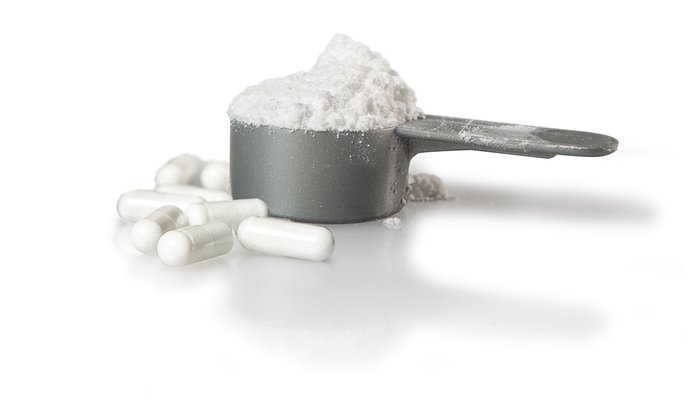Creatine is, without question, one the best supplements for increasing muscular strength, power, and size. But which type of creatine is best for you?
Over the years, several new and "improved" forms of creatine have hit the market, each claiming to be better than the original creatine monohydrate. Whether these varieties have been micronized, buffered, liquefied, or esterified, they all promise to deliver superior results—in some cases with a much smaller dose than suggested for the monohydrate form.

I'm here to sort through all the hype so you can understand which form of creatine can help you get the most gains!
Creatine Monohydrate
Advantage: Inexpensive and proven
Creatine monohydrate is the most widely used form of creatine, and the form used in most research studies. All the positive effects we associate with creatine use (increases in muscular strength, size, and power) come from studies of creatine monohydrate.
Manufacturers of other, newer forms of creatine claim that their version improves the percentage of creatine available to the muscles. But with as much as 99.1 percent of creatine monohydrate delivered to your skeletal muscles, there's not much for these newer forms to improve on.[1]
Buffered Creatine: Kre-Alkalyn
Advantage: No loading needed
Kre-Alkalyn is a form of creatine that contains a slightly alkaline powder, such as bicarbonate. Manufacturers claim that the addition of this "buffering" creates a slightly more alkaline compound, which can reduce creatine breakdown in the stomach and improve creatine uptake into the muscle. Kre-Alkalyn is both sold by itself and found in many pre-workouts.
Currently, only one study has evaluated the effectiveness of this buffered form of creatine. The 2012 study reported similar improvements in performance between subjects who took 5 grams of creatine monohydrate for 28 days, subjects who took an equivalent dose of Kre-Alkalyn, and subjects who took a low dose (1.5 grams) of Kre-Alkalyn per day.[2] The groups who supplemented with 5 grams per day also started with a seven-day loading protocol of 5 grams, four times a day, for seven days.
All groups significantly improved their fat-free mass, percent of body fat, bench press strength, and leg press strength, even the group that supplemented with a lower dose and no loading phase. It is important to note that the participants in the monohydrate group increased muscle creatine content by 50.4 percent at the end of 28 days, while the Kre-Alkalyn group increased by only 27.3 percent.
However, you're likely to see benefits whether you supplement with monohydrate or Kre-Alkalyn—and it appears you can still get the gains without the loading phase with Kre-Alkalyn.
Creatine Hydrochloride (HCL)
Advantage: Less water, minimal bloating
Manufacturers of creatine HCL market this form as providing more benefits than creatine monohydrate—even when you use a smaller dose (usually between 1-2 grams per day). Because it's a micronized form of creatine, HCL makers say, you can take less to achieve the same benefit. The claim is that since you consume less, you need less water, which helps with bloating and other gastrointestinal symptoms you can experience when taking monohydrate.
Although no data supports the claims that this form is superior to monohydrate, if you experience bloating or cramping when taking creatine, you may want to give it a try. While it is possible that HCL may be a superior supplement, any claims made without research to back them up should be taken with a large scoop of salt.
Creatine Nitrate
Advantage: Smaller dose required
Creatine nitrate is one of the newer supplement forms showing up in pre-workouts. Manufacturers claim that by binding the creatine molecule to a nitrate molecule, people will receive equal benefits from a smaller dose of creatine nitrate compared to creatine monohydrate.
A 2016 study measured the relationship between creatine nitrate and increased performance. It found no significant difference in lifting volume between nitrate and monohydrate groups, although people who took low-dose creatine nitrate supplementation did have an improved lifting volume compared to those who took a placebo.[3]
Preliminary findings suggest that creatine nitrate may be as effective as creatine monohydrate at enhancing exercise performance, as long as you've supplemented with creatine nitrate for at least 28 days.
And The Winner Is…
Exotic new forms of creatine notwithstanding, good old creatine monohydrate seems to win out time and time again. Monohydrate's high solubility and improved bioavailability make uptake into skeletal muscles very efficient—and makes monohydrate very tough to beat.

While some of these supplements show promise, more research needs to be done to evaluate their safety at higher dosages, as well as the comparative effects on performance from taking higher doses. Then, and only then, will we know if King Monohydrate has been dethroned.
References
- Jäger, R., Purpura, M., Shao, A., Inoue, T., & Kreider, R. B. (2011). Analysis of the efficacy, safety, and regulatory status of novel forms of creatine. Amino Acids, 40(5), 1369-1383.
- Jagim, A. R., Oliver, J. M., Sanchez, A., Galvan, E., Fluckey, J., Riechman, S., ... & Kreider, R. B. (2012). A buffered form of creatine does not promote greater changes in muscle creatine content, body composition, or training adaptations than creatine monohydrate. Journal of the International Society of Sports Nutrition, 9(1), 43.
- Galvan, E., Walker, D. K., Simbo, S. Y., Dalton, R., Levers, K., O’Connor, A., ... & Smith, S. B. (2016). Acute and chronic safety and efficacy of dose dependent creatine nitrate supplementation and exercise performance. Journal of the International Society of Sports Nutrition, 13(1), 12.

